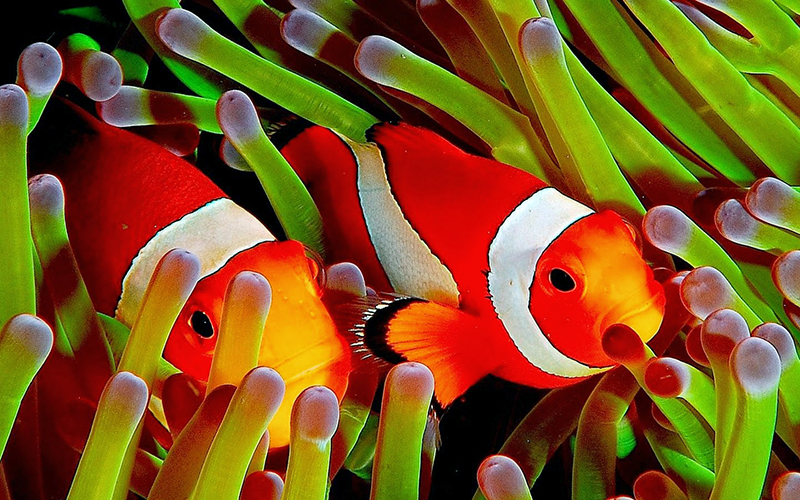Why Holes are Showing in Your Aquarium Crops
Chemical adjustments in synthetic waters are extra speedy than within the ambiance, the place it takes substantial adjustments within the air high quality for vital shifts to happen. Regardless of their capacity to adapt to most environments, Aquatic vegetation are prone to chemical, mechanical, and dietary influences.
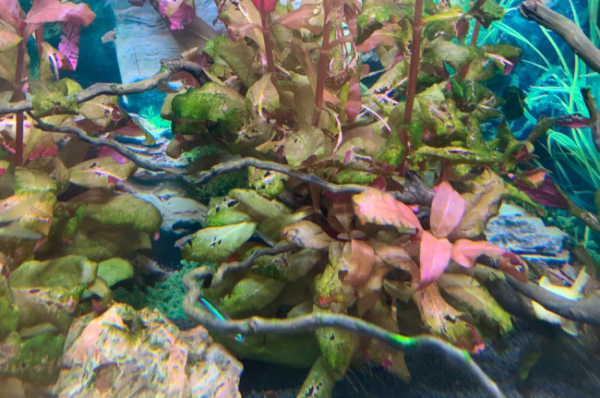
Holes or rots in aquarium plant leaves are typical in matured planted tanks. Crops often kill off older leaves by extracting all of the vitamins from them to develop new foliage. The unnatural frequency of yellowing leaves and the presence of holes, nonetheless, are trigger for concern.
On this article, we’ll undergo all the main causes behind the looks of holes in your aquarium vegetation and focus on mitigation methods for them.
Nutrient Deficiency
The first and incessantly the most typical purpose behind decay and holes showing in vegetation is nutrient deficiency. Lack of correct vitamins in water and fertilizers restrains the plant from delivering important components to the leaves. In making an attempt to nourish the newer leaves with the accessible vitamins, the older leaves are abandoned—inflicting holes in them.
Nutrient deficiencies that primarily trigger holes in aquarium vegetation are:
Potassium Deficiency
Potassium helps progress and helps resist illness in vegetation. Potassium additionally acts as a catalyst for enzyme activation and the opening and shutting of stomata.
Stunted progress, weakened root system, and pinholes in leaves are potent potassium deficiency signs showing in aquatic vegetation. The holes would usually be bordered with yellow or brown. A protracted lack of potassium usually causes chlorosis and necrosis in aquarium vegetation and will show to be deadly.
Potassium dietary supplements are by far the simplest methodology to mitigate the difficulty. Eliminating the reason for deficiency (for instance: algae or absence of enriched soil) earlier than dosing the potassium-rich liquid as per the directions must be adequate to revive the poked vegetation.
Finest potassium complement for aquarium vegetation: Seachem Flourish Potassium
Magnesium Deficiency
Magnesium is a central element of chlorophyll—the substance accountable for the inexperienced colour of leaves, that helps the vegetation seize daylight for photosynthesis. Magnesium additionally acts as a cofactor for a number of enzymes concerned in cell progress and carbohydrate metabolism.
As it’s also concerned within the transportation of different vitamins, magnesium deficiency principally impacts older leaves than youthful ones. The commonest symptom of which is chlorosis—yellowing or bleaching of the leaves, paired with the occasional look of holes. In some instances, magnesium deficiency additionally causes curled leaves.
Magnesium deficiency is normally triggered resulting from low water hardness and may be mitigated by water adjustments. Most industrial plant fertilizers (aquarium fertilizers) additionally comprise beneficiant quantities of magnesium to assist the nutrient steadiness.
Calcium Deficiency
Calcium is important to constructing the bodily energy of aquatic vegetation. Calcium is an integral part of plant cell partitions and supplies rigidity and stability to the tissues. Regulating enzyme exercise and signaling pathways for smoother membrane operate. Calcium additionally entails itself in cell division and elongation—guaranteeing total plant progress and shoot energy.
Holes and necrosis in new leaves, stunted progress, and curled leaf suggestions are indicative of calcium deficiency. Whereas older leaves stay unaffected initially, additionally they present discoloration and curling with extended calcium deficiency. Total, weak stems, poor progress, and a weakened immune system are attributable to a scarcity of calcium.
Mushy water lacks calcium. Therefore, determined and repeated use of RO/DI water depletes calcium within the water. A excessive stage of competing minerals, together with magnesium or potassium, can also hinder calcium uptake. Furthermore, inert substances additionally lack adequate calcium to replenish the necessities. Utilizing reasonably exhausting water and fertilizers ought to resolve the difficulty.
Phosphorus Deficiency
Phosphorus is a key element of ATP, the vitality foreign money of cells. With out the ample quantity of the identical, vegetation lack the vitality to carry out important organic processes, together with progress, photosynthesis, and cell restore. Phosphorus is even concerned within the creation of DNA and RNA. It additionally contributes to the manufacturing of phospholipids, important elements of cell membranes.
Phosphorous deficiency hinders cell division and might restrict progress potential. Extreme deficiency usually causes leaves to distort, twist, and deform—breaking and dying. The leaves lose their attribute inexperienced and switch into soggy yellow or brown. Most often, the leaves additionally turn out to be brittle and develop elongated holes.
Restrict utilizing phosphorus-absorbing foams and monitor your water high quality carefully, notably phosphate ranges. Supplementing the water with applicable fertilizers also needs to tackle the deficiency. Moreover, sure laterite-based substrates naturally launch phosphorus over time. Nonetheless, just be sure you aren’t overdosing your tank with phosphorus and selling algae progress within the tank.
Finest phosphate check package: API Phosphate Check Equipment

Finest phosphate fertilizer: Seachem Flourish Phosphorus

Sulfur Deficiency
Sulfur is an integral part for chlorophyll manufacturing. And not using a adequate provide of sulfur in both the water or the soil, your aquatic vegetation could develop circumstances much like magnesium deficiency.
Sulfur can be fairly concerned within the strategy of amino acid synthesis, which ensures the correct construction of proteins. Amino acids are fairly important for a number of plant capabilities, similar to enzyme exercise and protection mechanisms.
This macronutrient additionally helps vegetation develop resistance in opposition to environmental stresses and fluctuations in parameters.
The commonest indication of sulfur deficiency is the yellowing of leaves and the incidence of holes. Stunted progress, interveinal chlorosis, and weaker stems are additionally denotative of sulfur deficiency.
Having fish within the aquarium helps replenish the sulfur to an awesome extent. Driftwood and fertilizers may also be fairly useful on this regard. Nonetheless, easy water adjustments with de-chlorinated water (not RO/DI) can replenish the sulfur content material with out the danger of over-fertilization.
Nitrogen Deficiency
Just like magnesium, nitrogen is a key element of chlorophyll. With out sufficient nitrogen within the water, chlorophyll manufacturing declines and impacts the organic capabilities of each terrestrial and aquatic vegetation. Except for taking part in a task in nutrient uptake and utilization, nitrogen additionally contributes to protein synthesis and enzyme manufacturing.
Nitrogen deficiency limits chlorophyll manufacturing and causes the leaves to show yellow. It majorly impacts the older leaves and regularly extends to youthful foliage—beginning sometimes from the leaf suggestions. Unnatural leaf loss, translucent leaves, and stunted progress are additionally proof of nitrogen deficiency.
In a balanced ecosystem, nitrogen is delivered by the natural matter launched by the fish and rotting leaves. Nonetheless, filtration methods in aquariums usually break down the ammonia and nitrogen manner earlier than they can be utilized by the vegetation, for the residual elements to be eradicated by water adjustments.
Testing water parameters, particularly nitrate, and administering fertilizers wealthy with nitrogen are key to salvaging the difficulty. Though fish are an excellent supply of nitrogen, keep away from overstocking to stop ammonia poisoning.
Pest Infestation
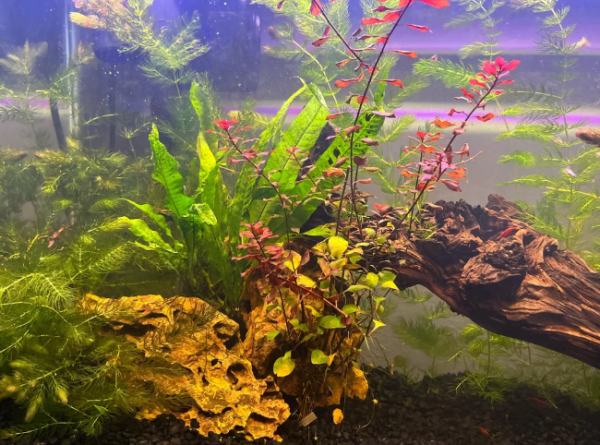
Aquatic pests usually nibble on vegetation, go away obtrusive holes, and strip them off of vitamin. Pests usually arrive within the tank by hitchhiking and normally keep successfully hidden. Most aquarium pests reproduce loads and are fairly difficult to remove with out vital effort, usually to the extent of restarting the tank.
A couple of widespread aquarium pests that eat vegetation are:
Snails
Largely stored as supplementary creatures for nutrient biking and to regulate algae, given optimum temperature and meals, snails can reproduce loads. Smaller snails particularly are infamous leaf-eaters, and their inhabitants can explode inside a number of weeks of introduction. Wild snails additionally usually hitchhike from different tanks with new vegetation and decorations.
Snail removing normally entails:
Eradicating snails is comparatively straightforward, particularly for bigger species. Merely pluck them off the vegetation and substrate by hand. Be additionally positive to take away the jelly-like egg clusters floating or caught on surfaces.
DIY traps, baited by lettuce or cucumber, may be nice for eliminating snails in clusters. You might also buy them on-line.
Predatory fish, similar to clown loaches and pea puffers, may be efficient in controlling the snail inhabitants. Nonetheless, they could even be incompatible with current fish and vegetation. Do your analysis earlier than introducing them to the tank.
Additionally Learn: How To Examine If A Snail Lifeless Or Sleeping: Full Information
Copepods
Copepods are detritivores and assist clear up decaying natural matter. Whereas they aren’t dangerous to fish or vegetation, they are often thought-about a “nice snack” for different pests like snails. They might additionally carry ailments and parasites which will infect your vegetation.
- Cleansing the tanks usually eliminates their meals supply and helps cut back their inhabitants.
- They’re drawn to mild and could also be gathered by shining a flashlight to be siphoned out.
- Don’t overfeed your tank inhabitants, as copepods reap the benefits of the uneaten meals.
- Small fish like rasboras, tetras, and guppies like to hunt copepods.
Planaria, limpets, and lots of different pests can also instantly and not directly hurt your vegetation. Think about eradicating them from the tank in the event that they’ve exploded in inhabitants.
Insufficient Lighting
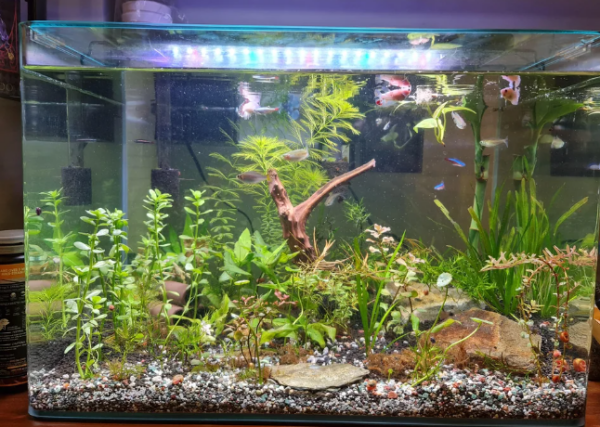
Crops require an enormous quantity of sunshine to transform oxygen and water into carbohydrates by photosynthesis. Insufficient lighting causes malnutrition and infrequently presents points like chlorosis, necrosis, and leaf holes.
On this part, we’ll focus on a number of lighting points which may be ensuing within the deformities in your vegetation.
Improper Day/Night time Lighting
Most vegetation produce meals within the day and burn saved vitality to develop across the clock. Opposite to standard perception, evening lighting is crucial for the expansion of vegetation and to replenish pure CO2 within the tank.
Lack of both daylight or nightlight can show to be detrimental to the well-being of your aquarium vegetation. They might develop to develop holes within the leaves and weak stems and carry out untimely leaf alternative.
In synthetic waters, aquarists make use of lighting methods with computerized timers that management the day/evening settings. Normally, 8-10 hours of daylight is ample for many aquatic vegetation. Providing not sufficient evening mild would fail to replenish the CO2 necessities through the day.
Lack of Full Spectrum Lighting
Full spectrum lighting settings maximize the expansion charge of the vegetation. Nonetheless, the absence of the identical could cause a number of well being points, together with a weakened immune system and necrosis in vegetation—inflicting leaves to rot and switch yellow.
Full spectrum lights usually embody a various variety of white, crimson, inexperienced, blue, and yellow lights. Many premium merchandise, nonetheless, additionally embody different colours to mimic each the ultraviolet and infrared spectrum.
You might contemplate a hygger 14W LED mild on your planted aquarium.
Insufficient Penetration
A majority of low cost aquarium lights can’t penetrate the water column and attain the underside regardless of having a large number of lights. This will increase competitors within the tank, and the youthful vegetation fall prey to the hostility.
Insufficient penetration could cause the decrease vegetation to starve and fall prey to malnutrition. The bigger vegetation can also strip vitamin away from the decrease leaves to nourish the foliage that’s being subjected to ample lighting.
When shopping for aquarium lighting, preserve an eye fixed out for one thing much like: “80 PAR @ 12in Depth” or “lumens.” These are the items for mild depth.
Fish Harm
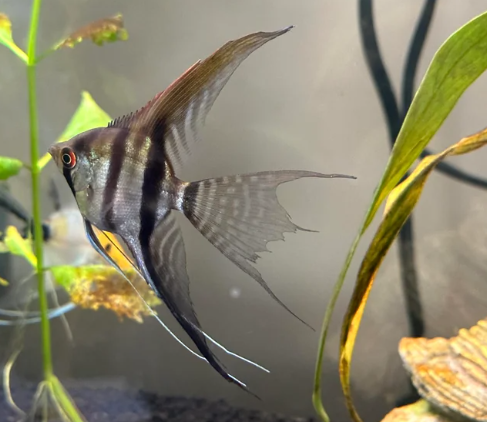
Quite a few fish species like to munch on leaves. Whereas herbivore fish are sometimes the primary offender, the behavior of plant obliteration hardly ever follows their weight loss plan desire. No matter their meals selection, fishes could often play with the leaves and uproot the vegetation.
Whereas the listing isn’t exhaustive, some typical plant destroyer species embody:
Until you need to keep away from maintaining these species within the tank, there is no such thing as a option to mitigate the problems. When you could use synthetic vegetation, that nullifies the purpose of this text. Nonetheless, you are able to do your analysis earlier than introducing new vegetation or new fish to your tank to keep away from or reduce the difficulty.
Water High quality Points
Water high quality points can also contribute to the looks of holes in your plant leaves.
pH Imbalance
Crops are normally extra resilient to water parameter adjustments than fish and invertebrates. Nonetheless, excessive pH deviations could cause stunted root and stem progress, flip leaves brown and yellow and limit particular nutrient uptake. Extreme pH imbalance instances can also be deadly to aquarium vegetation.
CO2 Deficiency
An overstocked tank, not sufficient evening mild, and a scarcity of supplementation trigger CO2 deficiency within the tank. It diminishes plant progress and infrequently leads youthful vegetation to loss of life resulting from competitors and stress.
Excessive Ammonia Ranges
Whereas dissolved ammonia is a superb supply of nitrogen for vegetation, an extreme quantity of it could show to be poisonous and promote algae progress. Algae bloom strips the vegetation away from important vitamins. An exorbitant stage of ammonia additionally signifies bigger points and calls for quick consideration.
Poor Water Circulation
Aquatic vegetation principally depend on the dissolved vitamins. Poor water circulation diminishes the method and will go away your vegetation with deficiencies regardless of having sufficient vitamins within the water. Oxygen and CO2 additionally have to be equipped to them by water circulation to carry out the metabolic processes.
Mitigation Methods
Monitoring water parameters and taking mandatory actions to deliver them to the optimum ranges is the important thing mitigation technique. Think about permitting water circulation all through each nook of the tank and administering fertilizers sparingly.
Mechanical Harm
Though uncommon, mechanical damages can also happen in planted tanks. A few of them embody:
Decorations
Sharp decorations could injury the leaves of your vegetation. In case you have fish which can be playful, they could additionally push the smaller decorations round and hurt the juvenile vegetation.
Water Currents
Whereas water circulation is important for vegetation to outlive, robust water currents could hurt the vegetation and even uproot them. Think about an informal circulation by the vegetation for the most effective outcomes.
Algae Scrubbing
Industrial algae scrubbers can hurt the leaves if not cautious sufficient. Alternatively, you could introduce algae-eating fish.
FAQs
Q: Why are my aquarium vegetation getting holes?
There are a number of explanation why your vegetation are getting holes. Nutrient deficiency, pest infestation, and irregular water parameters are thought-about the first purpose behind plant points.
Q: Why are my aquarium vegetation dissolving?
Aquarium vegetation dissolve resulting from nutrient deficiencies. A scarcity of potassium, calcium, nitrogen, and magnesium can decay your vegetation.
Q: What are the indicators of low CO2 in planted aquariums?
Yellowing or wilting of leaves and stunted progress are the indicators of low CO2 in planted aquariums. CO2 supplementation and growing evening mild are efficient mitigation methods.
The Backside Line
We’ve compiled a listing of causes behind the looks of holes in your aquarium vegetation. Hopefully, you’ll now have the ability to diagnose the difficulty and embrace mitigation methods in keeping with it.
